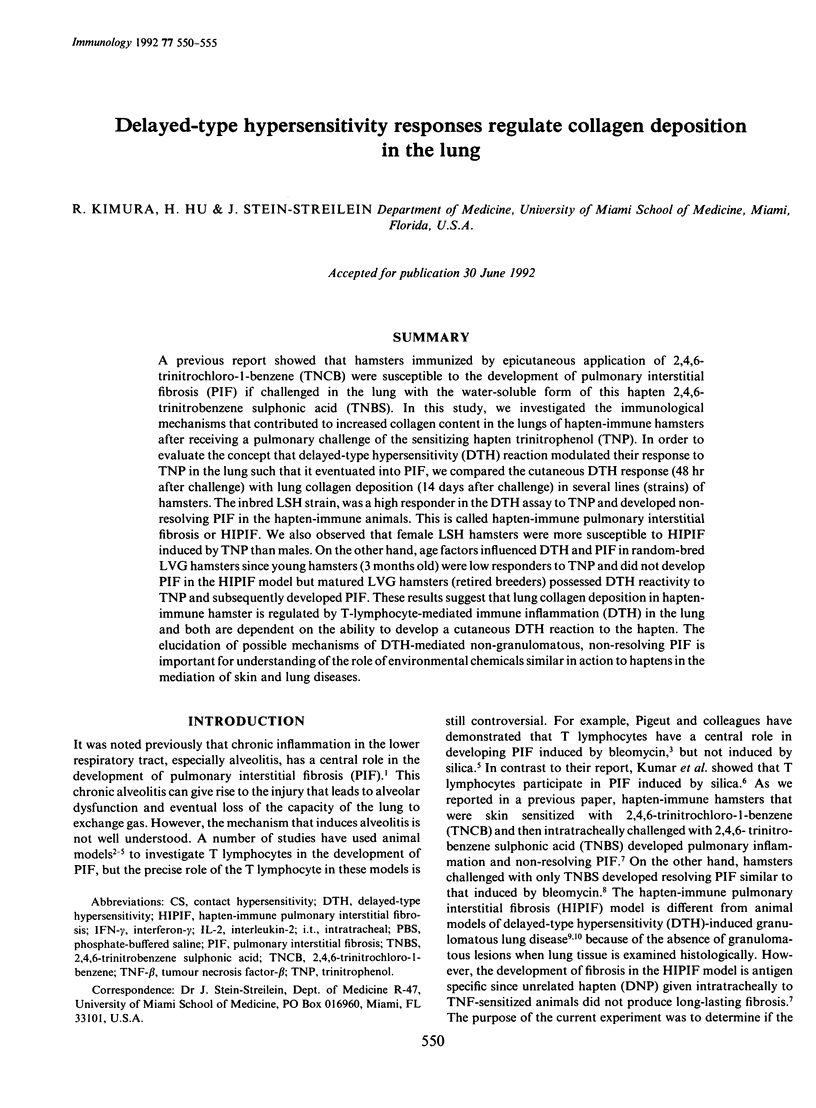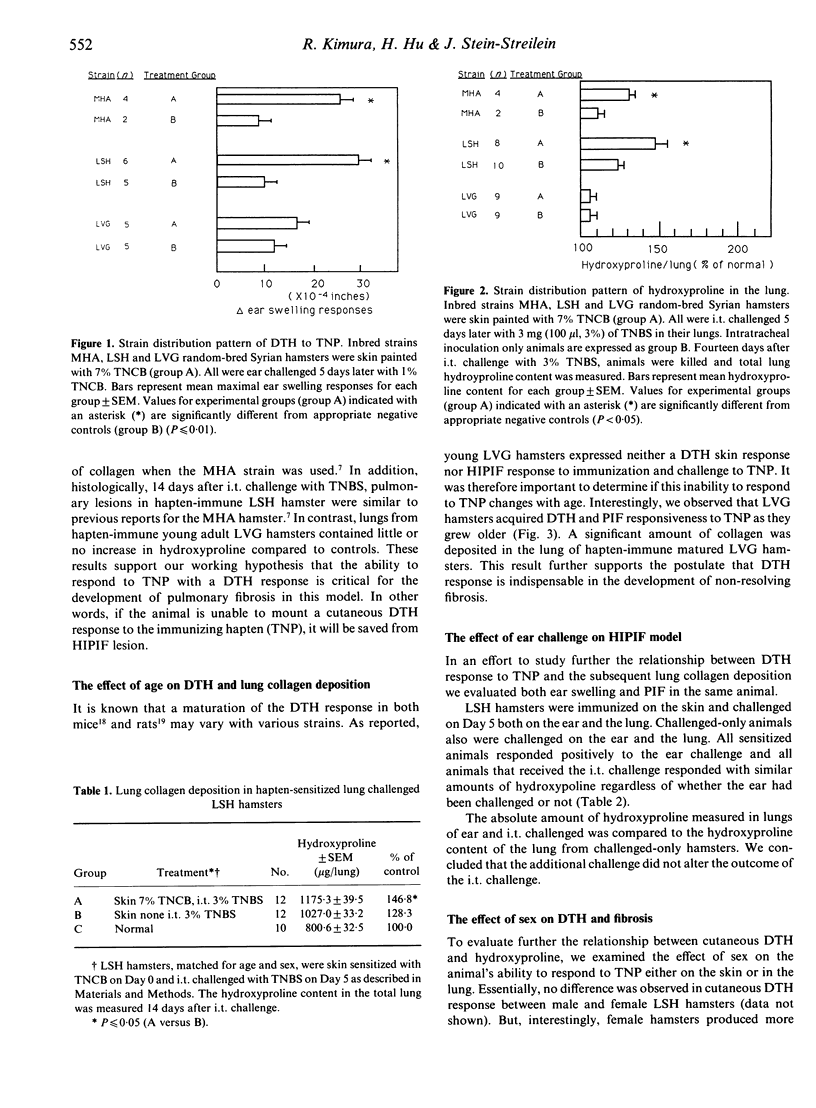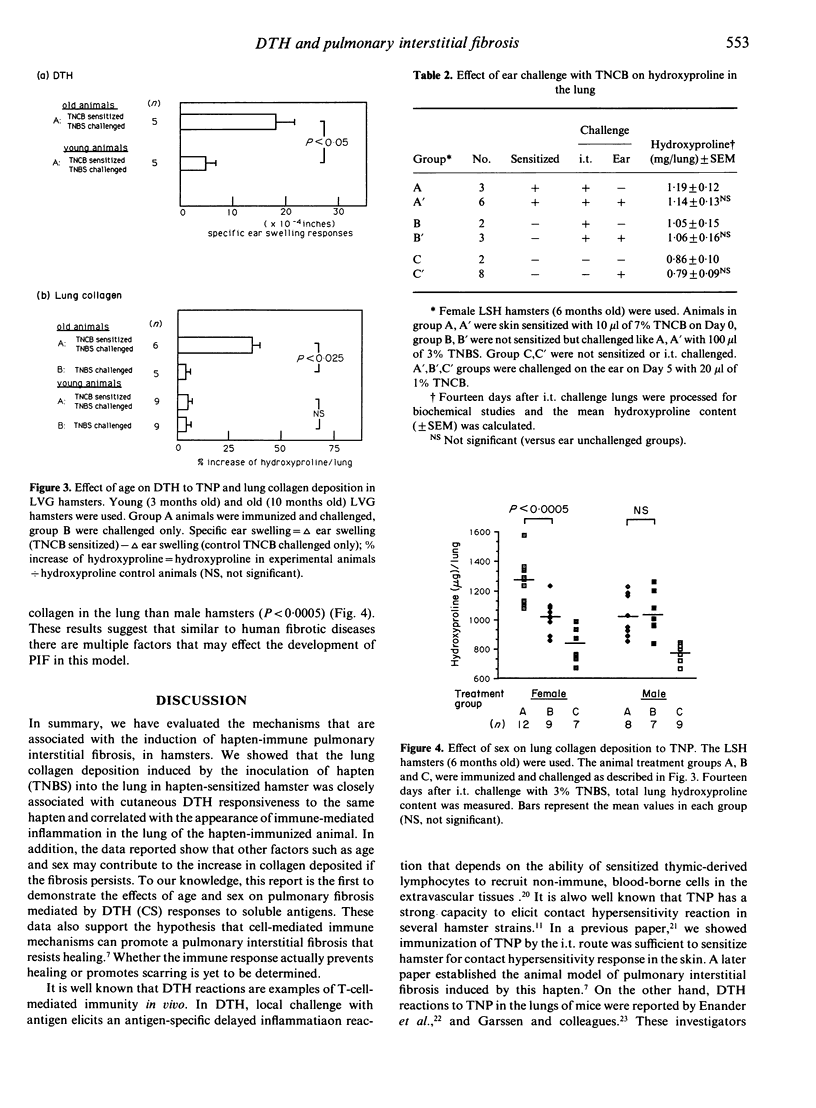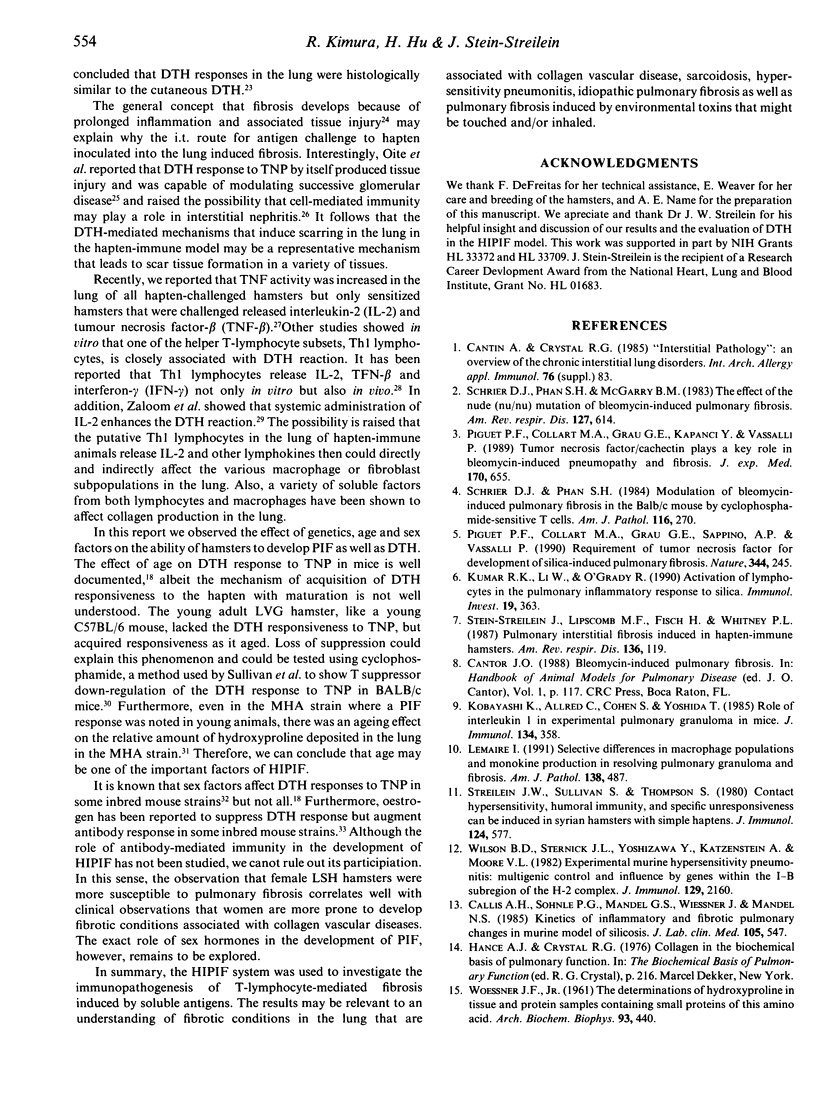Abstract
A previous report showed that hamsters immunized by epicutaneous application of 2,4,6-trinitrochloro-1-benzene (TNCB) were susceptible to the development of pulmonary interstitial fibrosis (PIF) if challenged in the lung with the water-soluble form of this hapten 2,4,6-trinitrobenzene sulphonic acid (TNBS). In this study, we investigated the immunological mechanisms that contributed to increased collagen content in the lungs of hapten-immune hamsters after receiving a pulmonary challenge of the sensitizing hapten trinitrophenol (TNP). In order to evaluate the concept that delayed-type hypersensitivity (DTH) reaction modulated their response to TNP in the lung such that it eventuated into PIF, we compared the cutaneous DTH response (48 hr after challenge) with lung collagen deposition (14 days after challenge) in several lines (strains) of hamsters. The inbred LSH strain, was a high responder in the DTH assay to TNP and developed non-resolving PIF in the hapten-immune animals. This is called hapten-immune pulmonary interstitial fibrosis or HIPIF. We also observed that female LSH hamsters were more susceptible to HIPIF induced by TNP than males. On the other hand, age factors influenced DTH and PIF in random-bred LVG hamsters since young hamsters (3 months old) were low responders to TNP and did not develop PIF in the HIPIF model but matured LVG hamsters (retired breeders) possessed DTH reactivity to TNP and subsequently developed PIF. These results suggest that lung collagen deposition in hapten-immune hamster is regulated by T-lymphocyte-mediated immune inflammation (DTH) in the lung and both are dependent on the ability to develop a cutaneous DTH reaction to the hapten. The elucidation of possible mechanisms of DTH-mediated non-granulomatous, non-resolving PIF is important for understanding of the role of environmental chemicals similar in action to haptens in the mediation of skin and lung diseases.
Full text
PDF





Selected References
These references are in PubMed. This may not be the complete list of references from this article.
- Callis A. H., Sohnle P. G., Mandel G. S., Wiessner J., Mandel N. S. Kinetics of inflammatory and fibrotic pulmonary changes in a murine model of silicosis. J Lab Clin Med. 1985 May;105(5):547–553. [PubMed] [Google Scholar]
- Carlsten H., Holmdahl R., Tarkowski A. Analysis of the genetic encoding of oestradiol suppression of delayed-type hypersensitivity in (NZB x NZW) F1 mice. Immunology. 1991 Jun;73(2):186–190. [PMC free article] [PubMed] [Google Scholar]
- Carlsten H., Holmdahl R., Tarkowski A., Nilsson L. A. Oestradiol- and testosterone-mediated effects on the immune system in normal and autoimmune mice are genetically linked and inherited as dominant traits. Immunology. 1989 Oct;68(2):209–214. [PMC free article] [PubMed] [Google Scholar]
- Duncan W. R., Streilein J. W. Analysis of the major histocompatibility complex in Syrian hamsters. I. Skin graft rejection, graft-versus-host reactions, mixed lymphocyte reactions, and immune response genes in inbred strains. Transplantation. 1978 Jan;25(1):12–16. [PubMed] [Google Scholar]
- Enander I., Ulfgren A., Nygren H., Larsson P., Holmdahl R., Klareskog L., Ahlstedt S. Regulation by T cells of delayed hypersensitivity reaction in mouse lung as reflected by mononuclear cells, mast cells and mucus-producing cells. Int Arch Allergy Appl Immunol. 1988;85(3):374–380. doi: 10.1159/000234535. [DOI] [PubMed] [Google Scholar]
- Garcia H., Salter-Cid L., Stein-Streilein J. Persistent interleukin-2 activity and molecular evidence for expression of lymphotoxin in the hapten-immune model for pulmonary interstitial fibrosis. Am J Respir Cell Mol Biol. 1992 Jan;6(1):22–28. doi: 10.1165/ajrcmb/6.1.22. [DOI] [PubMed] [Google Scholar]
- Garssen J., Nijkamp F. P., Wagenaar S. S., Zwart A., Askenase P. W., Van Loveren H. Regulation of delayed-type hypersensitivity-like responses in the mouse lung, determined with histological procedures: serotonin, T-cell suppressor-inducer factor and high antigen dose tolerance regulate the magnitude of T-cell dependent inflammatory reactions. Immunology. 1989 Sep;68(1):51–58. [PMC free article] [PubMed] [Google Scholar]
- Kobayashi K., Allred C., Cohen S., Yoshida T. Role of interleukin 1 in experimental pulmonary granuloma in mice. J Immunol. 1985 Jan;134(1):358–364. [PubMed] [Google Scholar]
- Kumar R. K., Li W., O'Grady R. Activation of lymphocytes in the pulmonary inflammatory response to silica. Immunol Invest. 1990 Aug;19(4):363–372. doi: 10.3109/08820139009050776. [DOI] [PubMed] [Google Scholar]
- Lemaire I. Selective differences in macrophage populations and monokine production in resolving pulmonary granuloma and fibrosis. Am J Pathol. 1991 Feb;138(2):487–495. [PMC free article] [PubMed] [Google Scholar]
- Mosmann T. R., Coffman R. L. Heterogeneity of cytokine secretion patterns and functions of helper T cells. Adv Immunol. 1989;46:111–147. doi: 10.1016/s0065-2776(08)60652-5. [DOI] [PubMed] [Google Scholar]
- Nakamura K., Aizawa M. Studies on the genetic control of picryl chloride contact hypersensitivity reaction in inbred rats. Transplant Proc. 1981 Jun;13(2):1400–1403. [PubMed] [Google Scholar]
- Neilson E. G., Jimenez S. A., Phillips S. M. Cell-mediated immunity in interstitial nephritis. III. T lymphocyte-mediated fibroblast proliferation and collagen synthesis: an immune mechanism for renal fibrogenesis. J Immunol. 1980 Oct;125(4):1708–1714. [PubMed] [Google Scholar]
- Oite T., Shimizu F., Kagami S., Morioka T. Hapten-specific cellular immune response producing glomerular injury. Clin Exp Immunol. 1989 Jun;76(3):463–468. [PMC free article] [PubMed] [Google Scholar]
- Piguet P. F., Collart M. A., Grau G. E., Kapanci Y., Vassalli P. Tumor necrosis factor/cachectin plays a key role in bleomycin-induced pneumopathy and fibrosis. J Exp Med. 1989 Sep 1;170(3):655–663. doi: 10.1084/jem.170.3.655. [DOI] [PMC free article] [PubMed] [Google Scholar]
- Piguet P. F., Collart M. A., Grau G. E., Sappino A. P., Vassalli P. Requirement of tumour necrosis factor for development of silica-induced pulmonary fibrosis. Nature. 1990 Mar 15;344(6263):245–247. doi: 10.1038/344245a0. [DOI] [PubMed] [Google Scholar]
- Schrier D. J., Phan S. H., McGarry B. M. The effects of the nude (nu/nu) mutation on bleomycin-induced pulmonary fibrosis. A biochemical evaluation. Am Rev Respir Dis. 1983 May;127(5):614–617. doi: 10.1164/arrd.1983.127.5.614. [DOI] [PubMed] [Google Scholar]
- Schrier D. J., Phan S. H. Modulation of bleomycin-induced pulmonary fibrosis in the BALB/c mouse by cyclophosphamide-sensitive T cells. Am J Pathol. 1984 Aug;116(2):270–278. [PMC free article] [PubMed] [Google Scholar]
- Stein-Streilein J. Allergic contact dermatitis induced by intratracheal administration of hapten. J Immunol. 1983 Oct;131(4):1748–1753. [PubMed] [Google Scholar]
- Stein-Streilein J., Lipscomb M. F., Fisch H., Whitney P. L. Pulmonary interstitial fibrosis induced in hapten-immune hamsters. Am Rev Respir Dis. 1987 Jul;136(1):119–123. doi: 10.1164/ajrccm/136.1.119. [DOI] [PubMed] [Google Scholar]
- Streilein J. W., Sullivan S., Thompson S. Contact hypersensitivity, humoral immunity, and specific unresponsiveness can be induced in Syrian hamsters with simple haptens. J Immunol. 1980 Feb;124(2):577–585. [PubMed] [Google Scholar]
- Streilein J. W., Witte P., Burnham K., Bergstresser P. R. Induction and regulation of contact hypersensitivity in Syrian hamsters. Adv Exp Med Biol. 1981;134:43–57. doi: 10.1007/978-1-4757-0495-2_5. [DOI] [PubMed] [Google Scholar]
- Sullivan S., Bergstresser P. R., Streilein J. W. Analysis of dose response of trinitrochlorobenzene contact hypersensitivity induction in mice: pretreatment with cyclophosphamide reveals an optimal sensitizing dose. J Invest Dermatol. 1990 May;94(5):711–716. doi: 10.1111/1523-1747.ep12876288. [DOI] [PubMed] [Google Scholar]
- WOESSNER J. F., Jr The determination of hydroxyproline in tissue and protein samples containing small proportions of this imino acid. Arch Biochem Biophys. 1961 May;93:440–447. doi: 10.1016/0003-9861(61)90291-0. [DOI] [PubMed] [Google Scholar]
- Wilson B. D., Sternick J. L., Yoshizawa Y., Katzenstein A. L., Moore V. L. Experimental murine hypersensitivity pneumonitis: multigenic control and influence by genes within the I-B subregion of the H-2 complex. J Immunol. 1982 Nov;129(5):2160–2163. [PubMed] [Google Scholar]
- Zaloom Y., Walsh L. P., McCulloch P., Gallagher G. Enhancement of a delayed hypersensitivity reaction to a contact allergen, by the systemic administration of interleukin-2. Immunology. 1991 Apr;72(4):584–587. [PMC free article] [PubMed] [Google Scholar]


